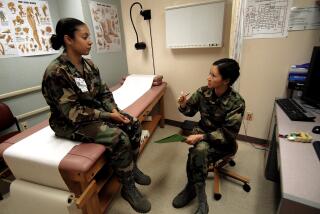Clothes May Make the Doctor Credible, Study Says
- Share via
Too many doctors look like slobs and could do with massive doses of dressing-up, a new study concludes, arguing that, for the sake of maintaining the confidence of their patients, physicians should deck out a little more--but not too much.
This may not be a research finding with strong Nobel Prize credentials, but it has been deemed important enough to be the lead article in a major medical journal, the Archives of Internal Medicine, this month.
The principal author of the study says it turns out that poorly dressed doctors may put off their patients enough that their slovenliness interferes with their medical effectiveness.
The new study, by researchers at the University of Minnesota Medical School, is the latest round in a controversy about how spiffy doctors should be. The dispute has been documented as far back as the time of Hippocrates, who argued that a physician should “be clean in person, well-dressed and anointed with sweet-smelling unguents.”
The dispute surfaces every now and then, either in lighthearted studies or letters to the editor in medical journals. This time, though, the Minnesota team launched an ambitious project in which 404 patients, interns and residents and staff physicians were asked what they thought was appropriate dress and appearance for doctors--both men and women.
The survey disclosed that the wearing of a name tag identifying the doctor as a doctor has an important psychological effect for patients, and nobody is impressed by a doctor who’s overweight, whether the physician is male or female. Blue jeans and corduroys don’t cut it for doctors of either gender, and wearing scrub suits and clogs is uniformly discouraged.
Other findings:
Male physicians should avoid long hair, earrings and other types of jewelry, going without socks and wearing sandals or athletic shoes. Male doctors should wear their hair above the collar, a white coat, dress shoes, a shirt and tie and dress pants. It helps to have a stethoscope visible too.
Female doctors should avoid prominent ruffles, dangling earrings, boots and patterned hose. They should wear white coats, nylons, lipstick, dress shoes and either a skirt and blouse or a skirted suit. Eye shadow is acceptable, as is mascara.
Dr. Dwenda Gjerdingen, who headed the research, said the issue of dress and appearance turns out to be more important than it might seem, because patients apparently make decisions about how much confidence to place in a doctor based on his or her appearance.






